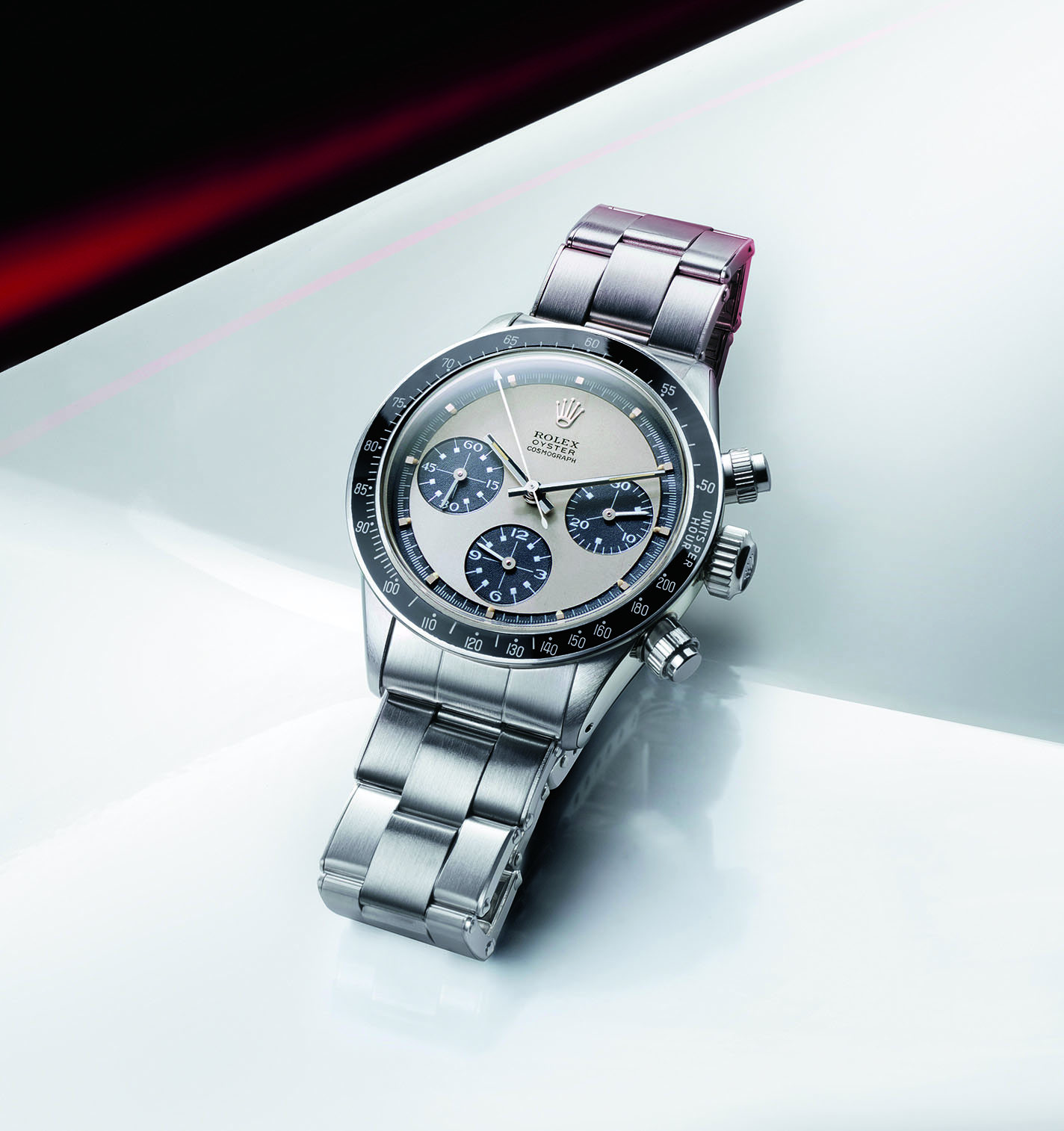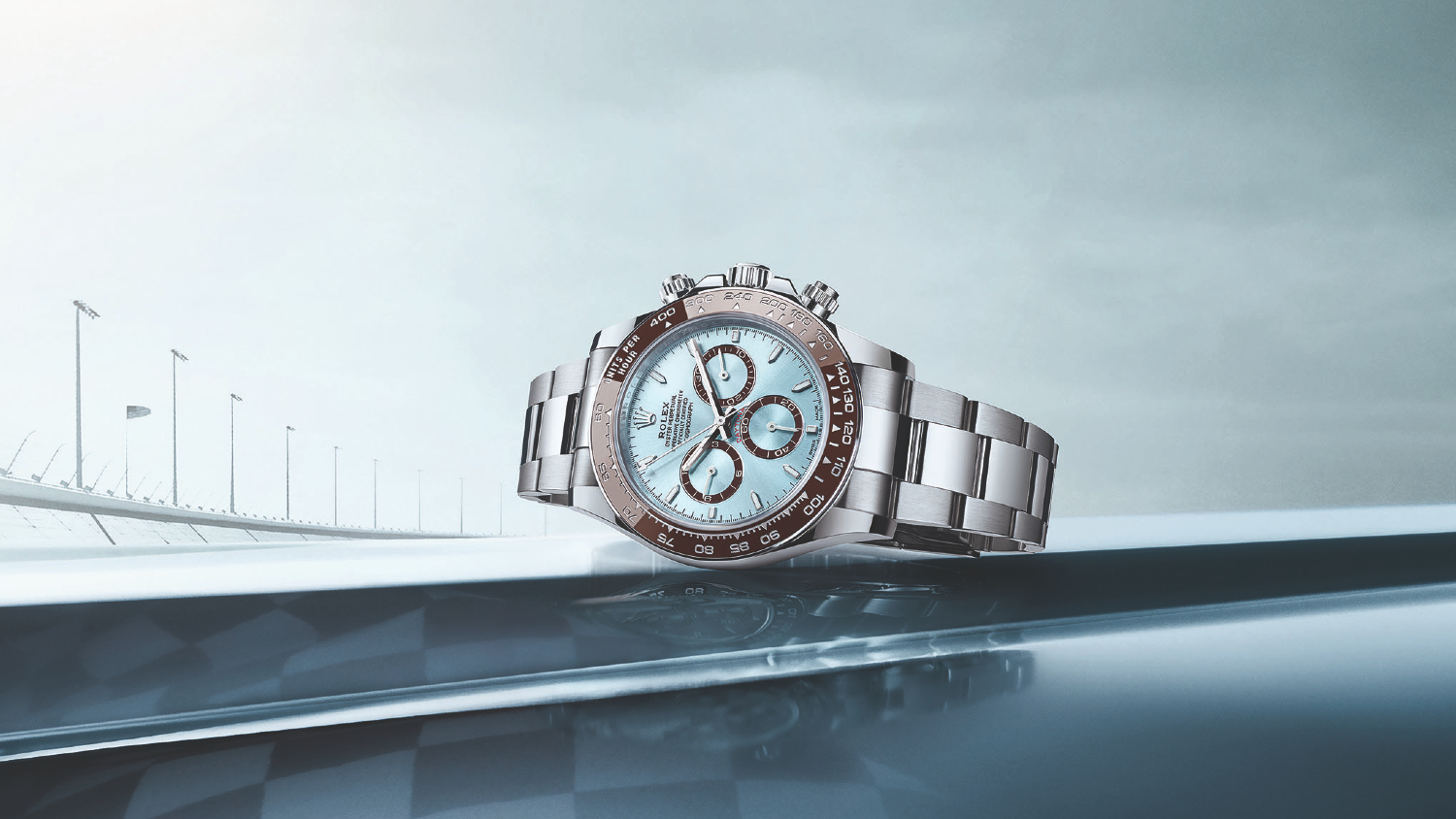In Rolex design, the Daytona occupies a special position of prominence. Most of its sport models are dominated by the Mercedes hand, the dial with circular and bar indexes, the distinctive Cyclops date magnifier, and often a rotating bezel with a dive or GMT scale. With the Submariner, Sea-Dweller, GMT-Master II, and Yacht-Master, a majority of the Rolex collection includes these features. On the more elegant models like the Datejust, we find narrow bar markers, often a fluted bezel, and obelisk hands. None of these features appear on the Daytona. Its design stands apart with unique applique indexes, a tachymeter scale on the bezel, and screw-down pushers. It is, so to speak, the third design category at Rolex and the only model whose features are found in no other Rolex watch. The Oyster bracelet is the only common attribute linking it to watches in other Rolex collections.
Rolex has worked continuously on refining the Daytona design profile. The first model in 1963 still had metal markers with luminous dots on the edge of the dial and a hand design it shared with the Datejust of the same era. The Ref. 6239 appeared first without, and then with, the ‘Daytona’ name, as the watch was known, thanks to the famous racetrack in Daytona Beach, Florida. Long before the racetrack, which is still in use today, was built, and even as early as the beginning of the 20th century, automobile races were held on the sandy beach where racers attempted to reach world-record speeds. ‘Daytona’ was a synonym for speed from the early days. Today, Rolex sponsors the 24 Hours at Daytona as well as other races like Formula 1 and the 24 Hours of Le Mans. Winners of these endurance races receive a Rolex Daytona with exclusive engraving on the caseback.
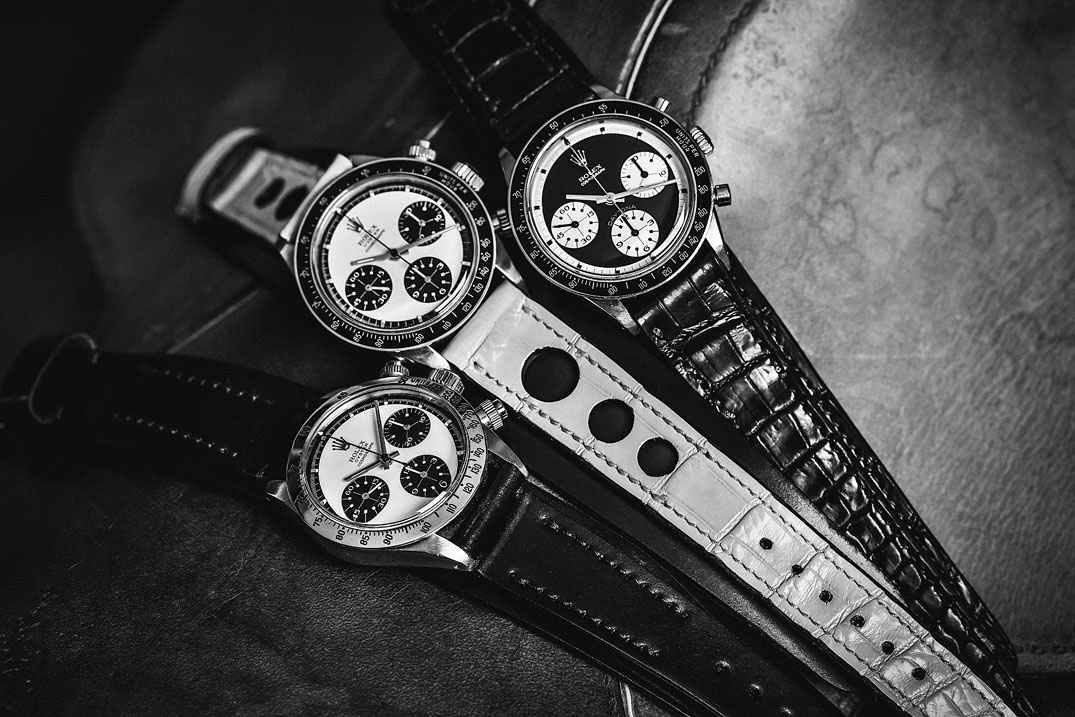 Paul Newman Daytonas from the 1960s with exotic dials are sought after
Paul Newman Daytonas from the 1960s with exotic dials are sought after
From the Beginning, Two Dials
The first Daytonas were available in two versions and only in steel: Equipped with a black dial with white subdials, or a white dial with black subdials. Other features still in place today are the tachymeter scale on the bezel, the obelisk hands, and the Oyster bracelet. The Paul Newman Daytona achieved great fame. A Daytona owned by the actor was sold at auction in 2017 for US $17.8 million and became the most expensive wristwatch in the world. Today, other Daytonas with the ‘Paul Newman’ name have the special dial, also called the ‘exotic dial’. On the one hand exotic, due to its initial unpopularity and since it is now relatively rare, and because of its unusual design with contrasting cream-coloured minute track and subdials, curving numerals, and square indexes.
These dials can be found occasionally on the successor models introduced in 1965. The Ref. 6240 debuted the now-characteristic screw-down pushers that are still part of the Daytona today. Another new style-defining feature was the black Bakelite insert in the bezel for improved legibility of the tachymeter scale.
Beginning in 1971, customers had choices: The Ref. 6263 had a black acrylic bezel, while the Ref. 6265 had a steel bezel, or a gold bezel for the gold models. The 37mm case size remained unchanged. And the movement also continued to be the hand-wound Caliber Valjoux 72, which Rolex modified with an improved
shock absorber.
Hand-wound Handicap
The Daytona in the 1970s and 1980s had no automatic movement like its competitors, which meant that relatively few of these models were sold. The Daytona gained greater popularity beginning in 1988 once Rolex replaced the hand-wound movement with a modified El Primero automatic calibre from Zenith. And with it, the Ref. 16520 brought major changes in design: A more modern 40mm case diameter, a wider steel bezel for improved legibility of the tachymeter scale, and a crown guard for sturdiness. Changes were also visible on the dial. Gone was the classical panda look for the steel versions. The subdials now featured contrasting rings for the track with the inner circle showing the dial colour. The now-characteristic applied markers appeared, and the hands were given modestly pointed tips to create balance. Overall, the design became significantly sportier. Rolex also offered models in both steel and yellow gold, which were joined by steel-and-gold versions and other gold tones.
A major change came in the year 2000 with the Ref. 116520, which primarily affected the inner workings: Rolex replaced the Zenith calibre with its own in-house automatic chronograph movement 4130. Then all Rolex models were equipped with in-house calibres and the Daytona became even more sought after. Visually speaking, the new power source was recognisable by two details: The small seconds moved from the 9 o’clock position to 6 o’clock, and the centre points of the two upper subdials were no longer aligned with the central hands but were now situated slightly higher. This resulted both in a pleasing, harmonic dial arrangement, and as a means to thwart forgeries.
Ceramic Bezel
The next major adjustment took place in 2016 when, with the launch of the Ref. 116500, Rolex introduced a black ceramic bezel on the popular steel models. Rolex milled the tachymeter scale directly into the ceramic and then deposited platinum in the grooves using the LIGA process. With the initial use of the material for the 2005 GMT-Master II, Rolex revived a design feature from 1965, the black bezel. This was also a way the company solved a functional problem. Up to that point, the Daytona’s wide polished steel bezel would quickly acquire unsightly scratches with wear. The version with a white dial was designed with black counter rings instead of silver to match the black bezel.
This step was not completely unexpected. In 2013, Rolex had already introduced a platinum version with a brown ceramic bezel and ice blue dial in honour of the 50th anniversary of the Daytona.
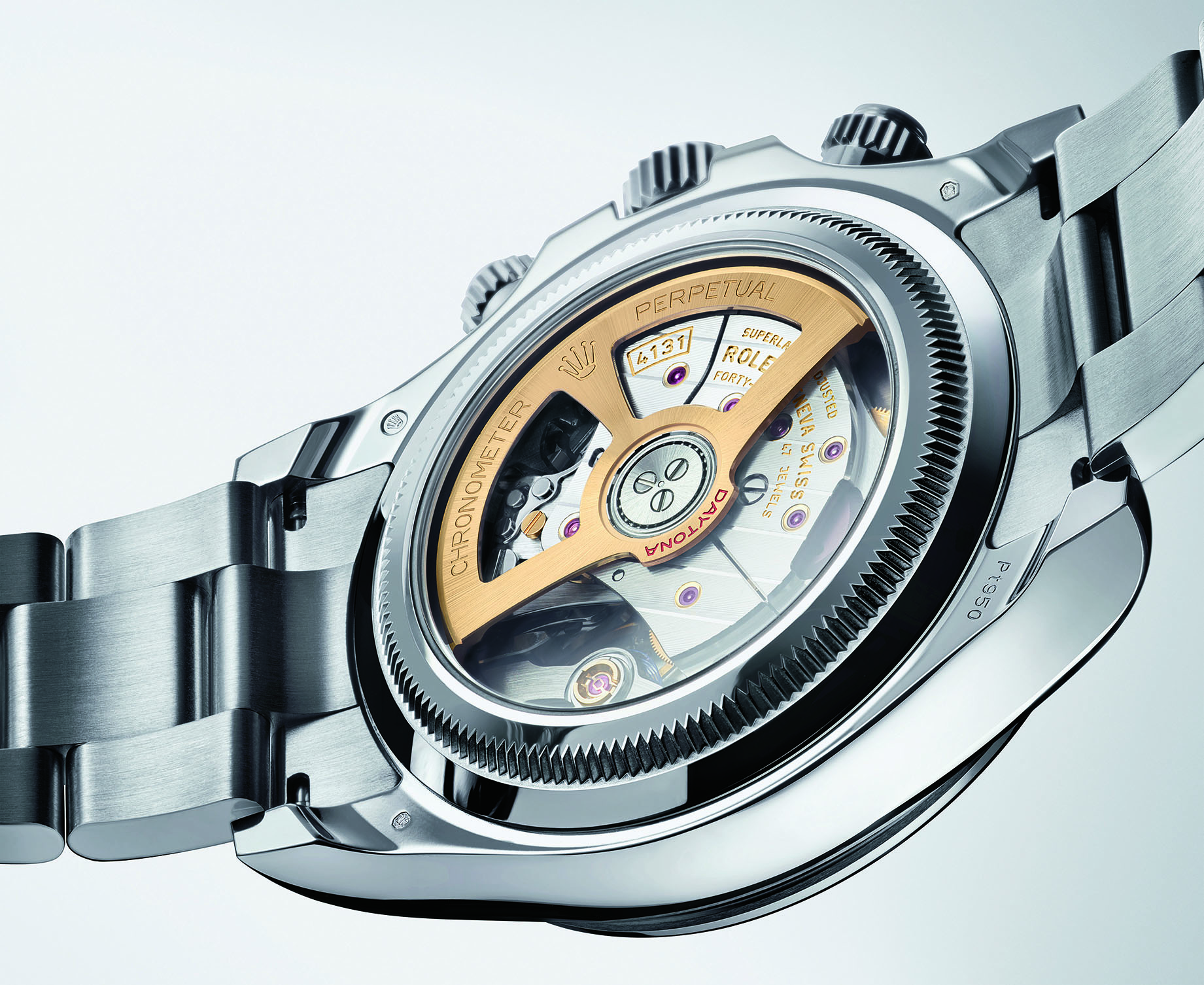 The platinum Daytona is the first Oyster model with a transparent caseback
The platinum Daytona is the first Oyster model with a transparent casebackThe year 2023 marks another anniversary for the Daytona, and Rolex presented the chronograph at Watches and Wonders in Geneva in March, reworked both in design and technology. The Caliber 4130 was upgraded with a Chronergy escapement to become the Caliber 4131. Externally, the evolution of the watch has been refined through the careful adjustment of several details. The unique applied markers are now longer and narrower, and accordingly, the hands are also narrower. The case is thinner (now measuring 11.9mm in thickness) and the crown guard has been extended. The left and right lugs are now not so obviously different in width and are also rounder. And the most apparent change is the matching metal frame around the ceramic bezel. These modifications were made not only to the new steel Ref. 126500LN but also the steel-and-gold, gold, and platinum versions. The reverse side of the platinum model shows an absolute first for Oyster models—it is the first to display the movement through a transparent caseback—known here as the Caliber 4132 with gold oscillating weight and other modifications.
But this unique selling point would not last for long. In June 2023, Rolex introduced a white-gold Daytona, issued to mark the 100th anniversary of the 24 Hours of Le Mans race. Both the red ‘100’ on the tachymeter scale as well as the 24-hour counter—twice as long as usual—make note of the anniversary of the race. Block indexes within white counters on the black dial are a clear reminder of the legendary Paul Newman Daytona.
Golden Diversity
Rolex has always been more ready to experiment with its gold Daytona models than with its steel versions, which have always been limited to two variations with white and black dials. For example, the gold watches might have so-called racing dials with radial hour numerals, or dials made of meteorite. There are also a few precious-metal models available with leather or rubber straps. The selection of dials is also considerably greater, and diamond indexes may be an option.
Extremely rare are two models with eye-catching gem settings. In 2018, Rolex introduced the attention-getting ‘Rainbow Daytona. Instead of a tachymeter scale, Rolex decorated the bezel of the Everose pink-gold watch with 36 sapphires in the colours of the rainbow and set 11 additional colourful sapphires on the dial as hour markers. And 56 diamonds sparkle on the case.
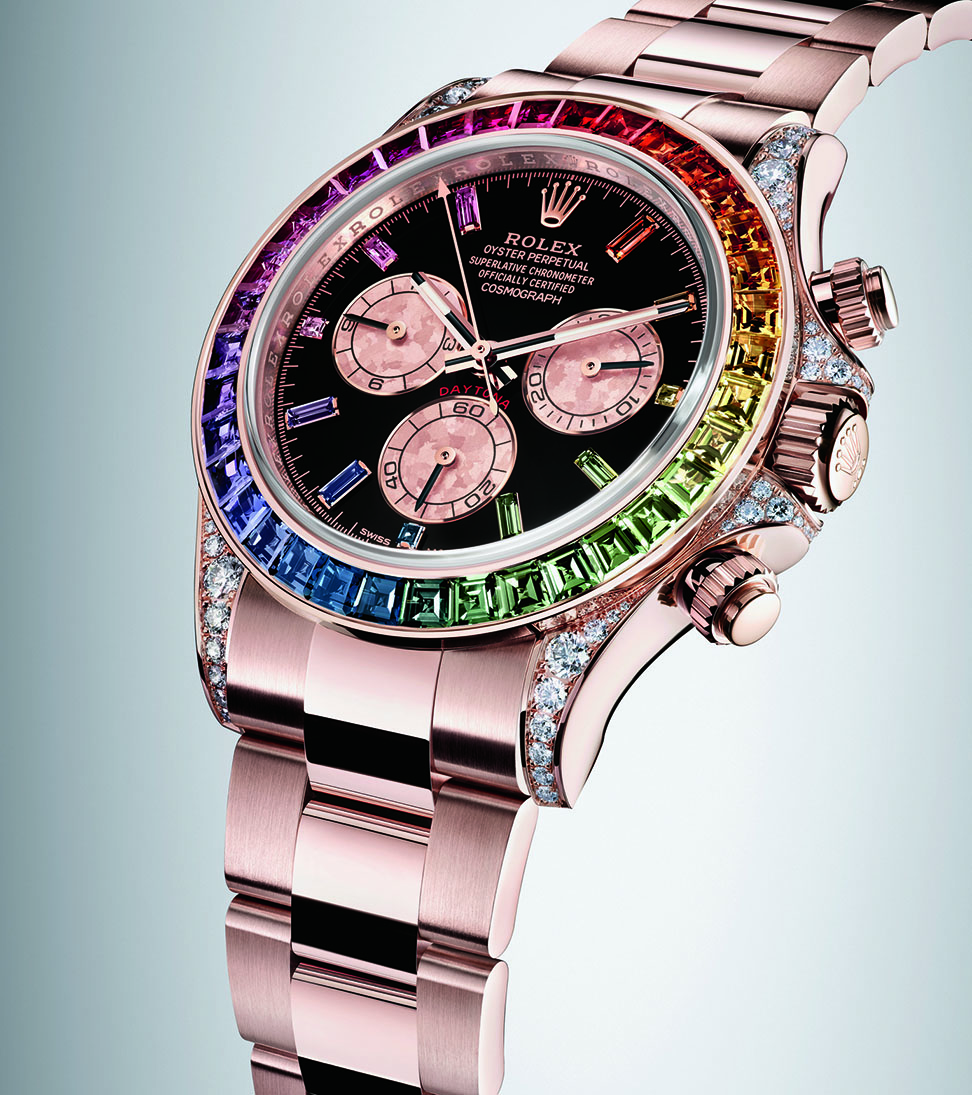 The ‘Rainbow’ Daytona from 2018 has a playful look
The ‘Rainbow’ Daytona from 2018 has a playful lookThe 2019 introduction of the ‘Eye of the Tiger’ watch is just as spectacular. Pavé diamonds on a black dial are set in a swirling pattern and outlined in gold, while trapeze-cut diamonds glitter on the bezel. Rolex combines its yellow-gold case with its Oysterflex rubber strap.
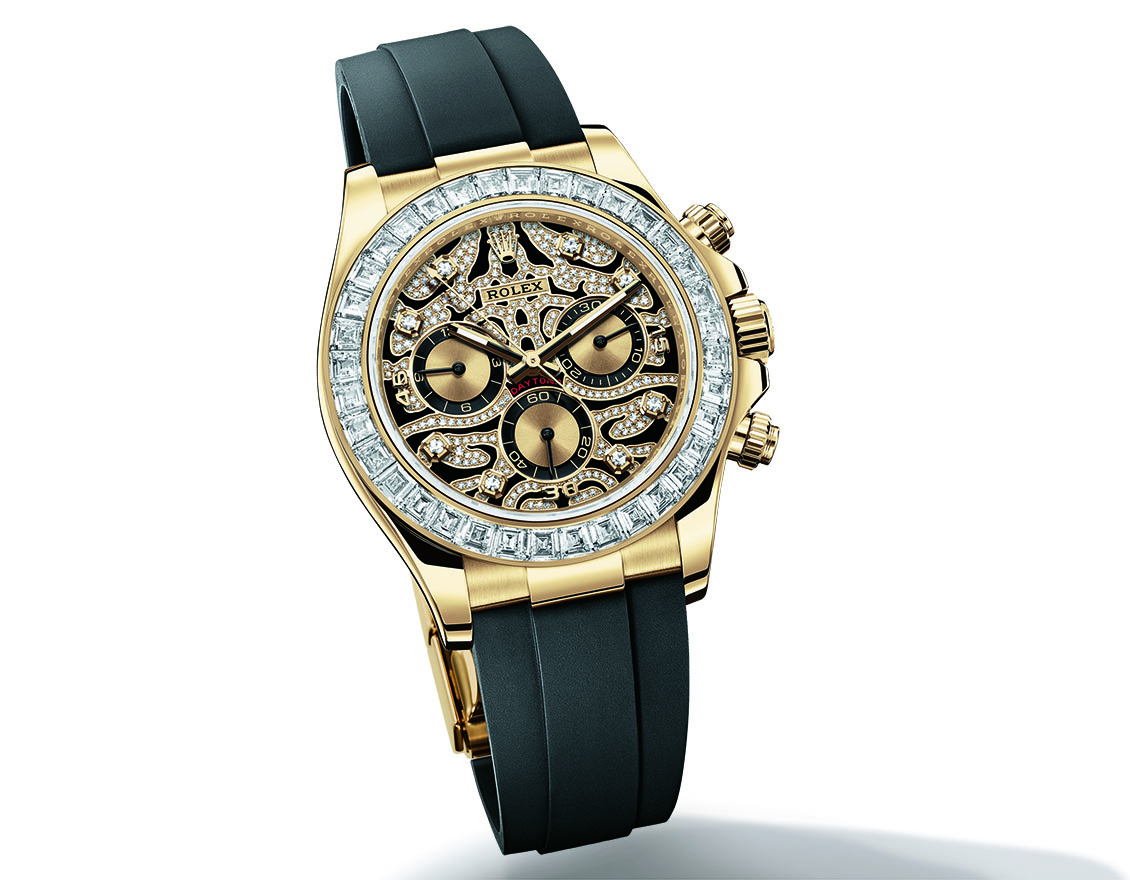 The ‘Eye of the Tiger’ with trapeze-cut diamonds on the bezel is spectacular
The ‘Eye of the Tiger’ with trapeze-cut diamonds on the bezel is spectacular Consistent Design
When rendered in precious metals, Rolex occasionally permits wider expression of the Daytona in playful and extremely expensive models. In steel, the Daytona maintains its visual rigour and consistently unique design that over time has given it the status of a design icon. Design has always played its part in the success of this
essential model.
Images: Courtesy Brand
This story first appeared on WatchTime India's Sports Watches 2023 print issue.
